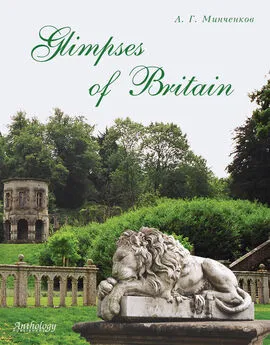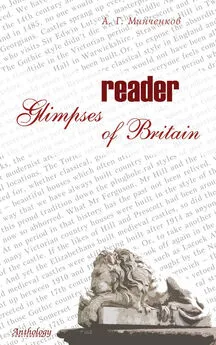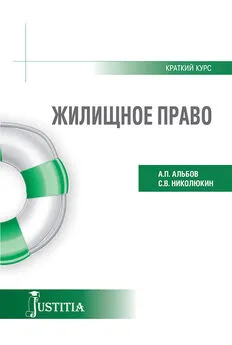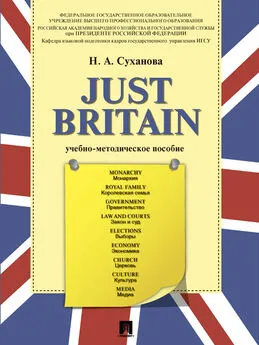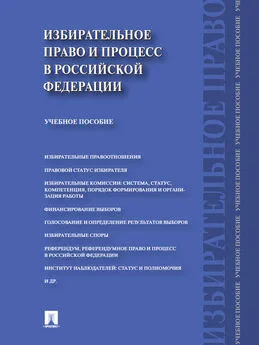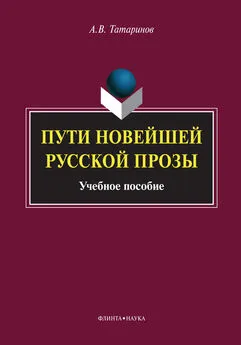Алексей Минченков - Glimpses of Britain. Учебное пособие
- Название:Glimpses of Britain. Учебное пособие
- Автор:
- Жанр:
- Издательство:Array Литагент «Антология»
- Год:2006
- Город:Санкт-Петербург
- ISBN:5-94962-114-X
- Рейтинг:
- Избранное:Добавить в избранное
-
Отзывы:
-
Ваша оценка:
Алексей Минченков - Glimpses of Britain. Учебное пособие краткое содержание
Пособие предназначено для студентов и школьников, занимающихся страноведением Великобритании, преподавателей, переводчиков и всех, кто интересуется историей, культурой и современной жизнью этой страны.
Glimpses of Britain. Учебное пособие - читать онлайн бесплатно ознакомительный отрывок
Интервал:
Закладка:
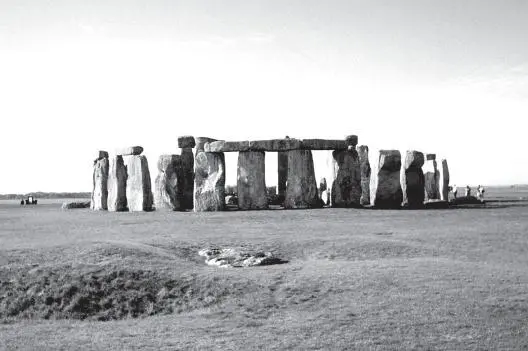
Stonehenge
The first document in the written history of the British Isles is a passage which records the visit to the Cornish peninsula of a Greek sea captain, Pytheas of Marseilles, about 320 B.C. At that time Britain was inhabited by the Celts. They were tribes from the upper Danube, who eventually settled in Italy, Spain and Britain. The Celts were an agricultural people who lived in farmsteads or villages. By the standards of those times, they were a rather advanced people, who could spin, weave, make pottery and metal items. They arrived in Britain from about 700 B.C. quickly taking over from the peoples who were already there. The Celts were divided into three classes: the nobles, whose task was to fight; the Druids, who acted as judges, teachers and dealt with the gods by means of magic; and the vast mass working on the soil.
For about 600 years the Celts lived in peace until, in the middle of the first century B.C., Julius Caesar decided to invade the island. The first time the Romans landed in 55 B.C., then again – in 54 B.C., when they pushed northwards, crossing the river Thames and conquering the whole of the south-east. Finally they made peace with the Celtic chiefs, who handed over hostages and promised an annual ransom.
The next major invasion came in 44 A.D. (Anno Domini, in the year of Our Lord), and then in 77 A.D. Britain became a province of the Roman Empire. The Roman governor Agricola advanced and conquered Scotland. For the first time the whole island was under single rule and to celebrate this a vast triumphal arch was built at Richborough. Eventually, however, Scotland was abandoned, and in 122 the Roman Emperor Hadrian came to Britain and ordered the building of a wall 80 miles long, across the northern border, in present-day Northumberland. Every 15 miles there was a fort and between each fort there were two watch towers. On the enemy side there was a ditch for protection, and a second one on the Roman side to facilitate the transportation of supplies. The wall was a remarkable achievement and much of it still stands.
From the middle of the 2nd century it makes sense to talk about a Romano-British culture. The Romans brought with them a number of profound changes, the greatest of which was the introduction of towns. Urban life was essential to them, but totally new to the Celts, who lived in scattered enclosures. Each Roman town had its own public baths, often several of them, with elaborate changing rooms, a gym, and cold, warm and hot baths. The Romans were masters in handling water; they built splendid aqueducts, drainage and sewerage system. Each town also had its own amphitheatre on the outskirts. Initially the towns were built without walls, but later, as the threats of invasion multiplied, they were added. Many modern British city names come from the Roman times: Gloucester, Leicester, Worcester, Winchester, and Chester. All these names are formed from the Latin word castra , which means an armed camp . One of the most spectacular Roman towns is Bath. Constructed over a hot spring that gushed water from underground, Bath was at once a marvel of hydraulic engineering, a showy theatre and a mysterious cult, a typical Romano-Celtic town. [3] In Dover the Romans built a 96-bedroom hotel, the last word in luxury.
The Romans also reorganized the countryside by building villas. Villas began as modest farmhouses, but as time passed they became more luxurious, some of them were virtual palaces with comforts like under floor heating, mosaic floors and wall paintings. Just how numerous these villas were is revealed by the fact that archaeologists have discovered the sites of about 1,000 villas on the British Isles.
Roman Britain was held together by a strong system of government. The creation of towns and villas formed a ruling class that included Celts, who were romanized, lived in towns and spoke Latin. In the country Celtic survived as the language of the peasantry.
The Romans introduced new vegetables and fruits: cabbage, peas, apples, plums, cherries and walnuts. They were the first settlers on the British Isles who made formal gardens, in towns and around villas, and brought the domestic cat.
The Romans were tolerant in matters of religion, except in the case of cults that involved human sacrifice. The Druids used to burn people alive to mollify their gods and this practice was suppressed. Otherwise the Celtic gods lived on side by side with the Roman ones, the most important of whom were Jupiter, Juno and Minerva. The Roman temple built at Bath, for example, was dedicated to both the Roman goddess Minerva and the Celtic water deity Sulis. Christianity also reached Britain. Its early history is extremely obscure until, at the beginning of the 4th century (in 313, when the Emperor Constantine was converted) [5] Christianity became the official state religion of the Roman Empire. In 314 the bishops of York, London and Lincoln went from England to a Council of the Church held at Arles. In 391 the Emperor Theodosius ordered the closure of all pagan temples. It is likely that many later Anglo-Saxon churches in fact go back to the Roman period.
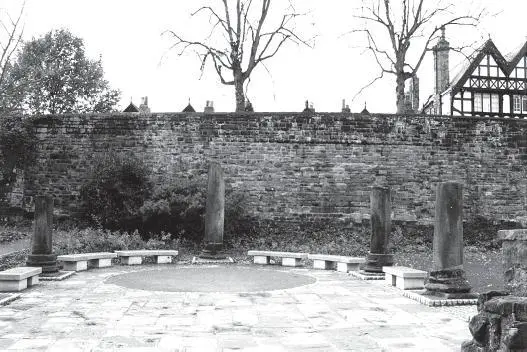
The Roman Garden in Chester
All in all, the Romans left an indelible legacy, one which contributed to the shape of what was to become English civilization, for the Romans never quite conquered the Celtic territories of Cornwall, Wales, or Scotland. The English language is unique among its Germanic cousins for the very large number of words which came into it from Latin.
When the Romans went they left behind a leaderless and defenceless people (in fact the Emperor Honorius sent his famous directive telling the British that they must now defend themselves), and these were no match for the fierce tribes that came to the British Isles. However, the change of civilization didn’t occur overnight. It was only by the 6th century that a different map of Britain began to emerge, one made up of a series of small independent kingdoms. The long process by which Roman Britain moved into the Anglo-Saxon kingdoms was a gradual one of adaptation. For a long time the Anglo-Saxons were a tiny minority that lived in the midst of an overwhelmingly Romano-Celtic population.
Invaders came from every direction. There were the Scots from Ireland who attacked the west, the Picts from the far north who penetrated south, and the Anglo-Saxons who landed in the south-east and East Anglia. The Anglo-Saxons were made up of various tribes who came from an area stretching between the mouths of the rivers Rhine and Elbe. A group of them was called Engle and from that came the word England. The Anglo-Saxons were pagans who worshipped gods such as Woden, Thor and Freya, whose names were to give the English language the words Wednesday, Thursday and Friday. The Anglo-Saxons had no interest in the Roman way of life, their society was differently organized. At the top came the nobles who fought, next the ceorls (freemen) who farmed and, at the bottom, slaves. The Anglo-Saxons didn’t live in towns, but in wooden huts. Their whole existence was war. Fighting bound them together in ties of loyalty to their leader. Loyalty was seen as the greatest of human virtues and the most detestable of all crimes was the betrayal of a king.
The Angles and Saxons took possession of all the land as far as the mountains in the north and west, and divided it into a handful of small kingdoms. In the south-east there was the kingdom of Kent and the south Saxon kingdom (Sussex), in the east – the kingdom of East Saxons (Essex), in the Midlands – Mercia, in the north – Northumbria, in the south-west – Wessex. Eventually the Christian Celts were wholly defeated; those who escaped death were pushed back into the mountains of Wales and Scotland, and also to Ireland, where their languages – Welsh, Gaelic and Erse – can still be heard.
In 597 Pope Gregory sent a mission to convert the Anglo-Saxons to Christianity. It is believed that the mission was inspired by the pope meeting a group of fair-haired youths in Rome. He asked them who they were and what their country of origin was. They answered that they were Engles, Angli in Latin. The pope is said to have remarked that he saw them not as Angli , but Angeli , that is angels. The papal mission was led by St. Augustine, and the missionaries made their base at Canterbury. The king of Kent, Ethelbert, fearing magic, insisted that his meeting with the missionaries take place beneath an open sky. Out of this came the grant of a place in Canterbury in which they could live and had permission to preach. Soon there were many converts, old churches began to be restored and new ones built. After a year Ethelbert himself became Christian. Augustine was consecrated Bishop and later Archbishop of Canterbury. Yet, that mission was only the beginning of the conversion of the Anglo-Saxons, a task that took most of the 7th century to achieve.
Monasteries such as Canterbury became centres of teaching and learning, where both Greek and Latin were taught, as well as so called Seven Liberal Arts that included the trivium – grammar or the art of writing, rhetoric or the art of speaking and the dialectic, the art of reasoned argument – and the quadrivium – arithmetic, geometry, astronomy and music. The most famous of all these scholars was the monk Bede (better known as the Venerable Bede), who wrote the History of the English Church.
Thus, by the 8th century a new society, deeply Christian, had come into being, only to face a new wave of invasions as fierce Northern people, the Vikings, began to attack from beyond the seas.
The story of Viking invasions is dramatically told in the Anglo-Saxon Chronicle, which traces how these raids accelerated during the second half of the 8th century. The Vikings were a people from Scandinavia, mainly Norway, Sweden and Denmark, whose life originally consisted in working the land and fishing, but who went on to attack and later settle in Britain, Northern France, Russia, Iceland and Greenland. One of the basic reasons for their endless raids was that their homelands no longer produced enough to support them. Another was the nature of their society that glorified fighting. The Vikings were pagan and believed that the gods rewarded fighters above all and that bloodshed and death in battle were the true paths to wealth and happiness.
One by one the kingdoms of the Anglo-Saxons fell until there was only Wessex left, where a young man called Alfred came to the throne in 871. [15] During his reign, which lasted almost thirty years, the advance of the Vikings was stopped and the foundations of what was to become the kingdom of England were laid. We can easily trace where the Vikings settled, areas of the country known as the Danelaw, by the endings to the place names. Whereas the Anglo-Saxon endings were ‘hams’ and ‘tuns’ (homes and towns), the Vikings had their ‘bys’ and ‘thorpes’.
After being defeated by Alfred, the Vikings held the north and East Anglia, while the kingdom of Wessex gradually expanded to embrace all the southern Anglo-Saxons. In 886 Alfred captured London. In the peace he made with the Danish king the English and the Danes were accepted as equals and for the first time there is reference to ‘all the English race’.
Alfred took important steps to ensure the defence of his kingdom. He realized that the Anglo-Saxons must develop sea-power, so he ordered the construction of warships. Even more important was the building of a network of defended enclosures, ‘burhs’, in which people could seek safety along with their goods and cattle. These were strategically placed and were either on the site of old Roman towns or carefully chosen to be new ones. We can trace many of them today in place names that end in ‘borough’.
Читать дальшеИнтервал:
Закладка:
